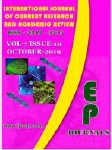Abstract Volume:7 Issue-10 Year-2019 Original Research Articles
 |
Online ISSN : 2347 - 3215 Issues : 12 per year Publisher : Excellent Publishers Email : editorijcret@gmail.com |
This study outlines the magnitude, rate and patterns of urban change over a period of 20 years using remotely sensed datasets with field work validation and integrated approaches of Remote Sensing and GIS tools. Remote sensing is a very useful tool for the affair of land use or land cover monitoring, which can be helpful to decide the allocation of land use and land cover. Mapping of LULC and change detection using remote sensing and GIS techniques is a cost effective method of obtaining a clear understanding of the land cover alteration processes due to land use change and their consequences. This study involves the assessment of land use or land cover changes beginning from the year 1999, 2009 and 2019 of Wolaita Sodo town. The study made use of Landsat imageries of 1999, 2009 and 2019. The images were classified using Maximum Likelihood classification algorithm in ERDAS IMAGINE 2014 and mapped using ArcGIS desktop 10.7. The images of the area have been categorized into five exceptional classes, specifically, agriculture, built-up, urban green, forest plantation and open space. The outcomes indicated that over the past 20 years, built-up land and forested land have been changed by 11.7% (1075.9ha.) and 6.5% (600.3 ha.) while agriculture, open areas and urban green have decreased by 5% (462.06), 5.6% (513.1 ha.) and 7.6% (700.4 ha.) respectively. The results indicated severe land use/cover changes over agricultural, built-up and unused open areas, constituted the most extensive type of land use/land cover in the study period. A number of factors such as socio-economic and political are responsible for the economic development and land use changes. The study reveals that that the town has experienced rapid changes in land use, particularly in terms of unplanned residential area and agricultural lands.
How to cite this article:
Teshome, M. 2019. The Role of Geoinformation Technology for Predicting and Mapping Urban Change Detection: WolaitaSodo town case study, Ethiopia.Int.J.Curr.Res.Aca.Rev. 7(10): 23-33doi: https://doi.org/10.20546/ijcrar.2019.710.004



Quick Navigation
- Print Article
- Full Text PDF
- How to Cite this Article
- on Google
- on Google Scholor
- Citation Alert By Google Scholar
